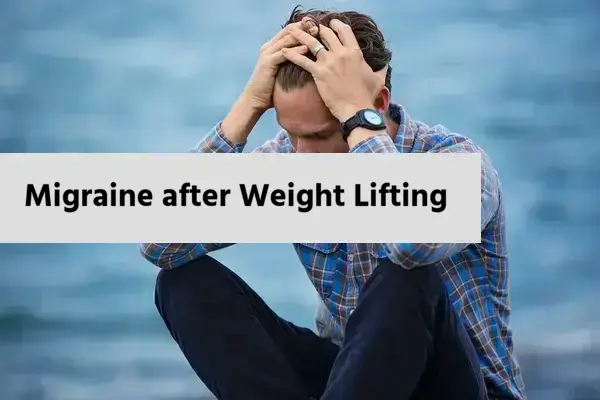Migraine headaches can be incredibly debilitating, and can affect anyone at any time. For some, however, the onset of a migraine may be linked to certain triggers or activities. One such trigger that is often overlooked is weight lifting.
While exercise and staying active is generally considered to be a positive thing for our health, for some individuals, weight lifting or other strenuous activities can lead to the development of a migraine headache.
In this blog post, we will explore the phenomenon of migraines after weight lifting and provide tips and strategies to help manage this common condition.
What is a headache after lifting weights and after exercise in general?
A headache after lifting weights, or any physical activity, is often referred to as an exertional headache. This type of headache can occur during or after exercise, lasting anywhere from a few minutes to a couple of days. Exertion headaches are a result of the blood vessels in the head and neck dilating from strenuous activity, causing pressure and pain.
Other factors such as dehydration, exercising in heat or at high altitudes, and muscle tension can contribute to exercise headaches as well. It is important to note that while exercise headaches can be uncomfortable, they are usually not a serious health concern.
Drinking plenty of water, warming up properly, and choosing low-impact activities can help prevent these types of headaches. It’s also important to maintain proper hydration and a healthy protein intake to support the body during physical activity. If stress is contributing to exercise headaches, incorporating relaxation techniques and stress management strategies can be helpful.
Symptoms
People who experience migraine after weight lifting may notice symptoms such as severe fatigue, chest pain, and eye pain. These symptoms may also be accompanied by vomiting. It is important to identify these symptoms as they may be indicative of an exercise headache.
The causes of such headaches may vary, but sweating and increased pressure on the blood vessels in the brain may be contributing factors. To prevent such headaches, it is recommended to start with light weights and gradually progress to heavier ones. Cooling down and staying hydrated post-exercise is also essential.
Additionally, including adequate protein in one’s diet may help reduce the risk of exercise-related headaches. By identifying the symptoms and following preventive measures, individuals may overcome the challenges associated with migraine after weight lifting.
Causes of headache after weight lifting
One of the causes of headache after weight lifting is dehydration. The body loses fluids during physical activity, and failure to replenish it can lead to headaches.
Moreover, low blood sugar levels due to poor diet can cause headaches. Another factor is over-exertion, which can cause tension headaches. Additionally, poor breathing techniques while lifting weights can also cause headaches.
People who experience migraines are also at risk of developing exercise-induced headaches. Therefore, it is important to take breaks during workouts and avoid over-exertion. Ensuring adequate hydration, proper nutrition, and good breathing techniques are essential in preventing headaches after weight lifting.
Understanding the causes of headaches after weight lifting can help one to prevent them and continue to reap the benefits of physical activity.
How to prevent headache after weight lifting
To prevent headaches after weight lifting, there are a few things that can be done. Firstly, it is important to warm up properly before starting the weight lifting routine. This can reduce sudden rises in intracranial pressure that can trigger a migraine.
Secondly, it is important to stay hydrated by drinking three to four glasses of water before the workout, and continuing to drink water throughout the day. Eating at least an hour and a half before exercising can also help prevent headaches. It is also helpful to mix up the workout routine.
Finally, it is important to listen to your body and stop exercising if a headache starts, and only return to the routine once the headache has gone away. Keeping in mind these preventative measures, individuals looking to stay physically active and migraine-free can enjoy their workout without any debilitating headaches.
Importance of hydration and protein intake
When it comes to preventing headaches after weight lifting, hydration and protein intake play a crucial role. Dehydration can lead to headaches and other health complications, so it’s important to drink plenty of water before, during, and after your workout.
Additionally, consuming protein after your workout can help to repair and rebuild muscle tissue, which can also help reduce the likelihood of a headache. Incorporating nutrient-rich foods and drinks into your diet can help ensure that you are properly hydrated and meeting your body’s protein needs.
Remember, prevention is key when it comes to avoiding exercise headaches, so taking care of your body before and after your workouts is essential for staying healthy and headache-free.
Relationship between stress and exercise headaches
Stress is often a major factor in causing exercise-induced headaches. As previously mentioned, work pressure and tension from severe stress can lead to recurring headaches, which may worsen after exercise.
Fatigue, muscle tension, and dehydration can also contribute to exercise-induced headaches. Therefore, it is important to manage stress levels alongside proper hydration and nutrition to prevent the onset of headaches.
It is also worth noting that certain sports, such as weight lifting, can create additional stress on the body, thus increasing the likelihood of an exercise-induced headache. While headaches after exercise can be common, there are steps that can be taken to reduce their frequency and severity, including cooling down properly and paying attention to overall stress levels.
By addressing these factors, individuals can enjoy the many health benefits of exercise without the added discomfort of headaches.
Sports associated with exercise headaches
Certain sports and physical activities are more likely to trigger exercise headaches than others. These activities include running, rowing, tennis, swimming, and weightlifting. While exercise is generally good for one’s health, it can also cause headaches for those who are not used to intense workouts.
This can include headaches like jogger’s headache and orgasmic headache, which can occur after strenuous activities. It’s important to stay hydrated, take in enough protein, and manage stress levels to prevent exercise headaches. Despite the risk of headaches, it’s still important to engage in physical activity for overall health and well-being.
About the Author
Reyus Mammadli is the author of this health blog since 2008. With a background in medical and biotechnical devices, he has over 15 years of experience working with medical literature and expert guidelines from WHO, CDC, Mayo Clinic, and others. His goal is to present clear, accurate health information for everyday readers — not as a substitute for medical advice.







